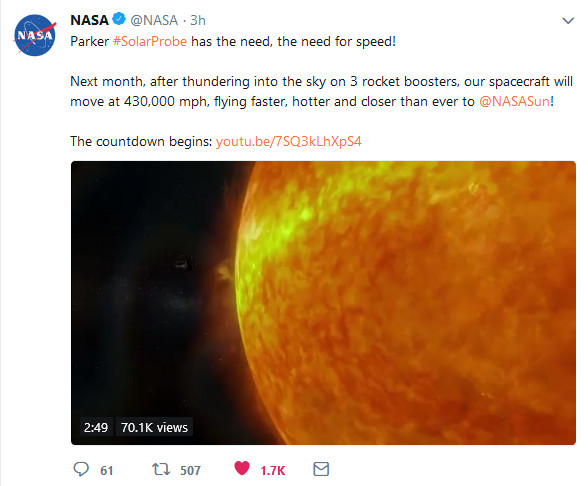https://apod.nasa.gov/apod/ap180625.html
very exciting science. cant wait for the return samples in 2020
https://apod.nasa.gov/apod/ap180625.html
very exciting science. cant wait for the return samples in 2020
You reminded me that the Pluto one, New Horizons, is still going and its going towards next place, and possibly even further if there is anything on its way
Secondly, similar to these others who have taken polar shots, Sun probe is launching this summer, but they did not state what year its going to be passing by Sun’s pole
I understood that its going to fling around Sun and then fling around planet, and I assumed its going to fling back towards Sun, and repat that kind of looping
the sun is so massive, it’s gona take years…
How…
That size is kinda similar to our equator blowing
But its going around? I’m guessing thats because there is no sea 
Wonder if Nasa would have some timelapse from starting point onwards
http://www.msss.com/msss_images/subject/weather_reports.html
18 June 2018 – 24 June 2018
11 June 2018 – 17 June 2018
4 June 2018 – 10 June 2018
From here onwards its the same aaaand the same, seems to be normal weather
28 May 2018 – 3 June 2018
I just picked up Universe Sandbox^2 from Steam. Holy crap, this thing is really incredible. You have such great granularity of control and tweaking. There’s also a tonne of pre-existing simulations loaded up like seeing what the “Perfectly Engineered System” would look like, or even to see Oumuamua fly through the solar system.
Probably a bunch of things, I imagine that less atmosphere, lower gravity, lack of moisture, and the Mars seems to be a giant planet of fine dust makes this an easy thing to happen. Its happened before in 2007.
The thing to see is how Opportunity will do, it generating almost zero power due to the storm, but should hopefully be fine once its passes.

I couldnt find any info from NASA about the actual flyby dates, but I found this thing
http://www.thesuntoday.org/mission-hub/parker-solar-probe/
Parker Solar Probe will pass Venus less than two months after launch and will be collecting science data at its first solar pass just one month later.
So, 3 months
haha i guess when you fly 430,000 mph it aint no thang
when it doubt, wiki got clout
Not sciency but “from space”, literally.
Any of you are watching Lunar Eclipse?
Guess NA is outa luck
It’s a bit cloudy here, my camera gear is pretty much useless nor are my skills as a photographer any good.
Took some very shitty pics:
https://forum.level1techs.com/t/the-lounge-2018-07-july-novatsy-rgb-edition/128861/24830
Nobody recognizes some sagittarius
For me
0000-0200
right side of moon
cygnus and aquila cross birdies are too far
Found new source for videos

This is what I always try to find from actual NASA content but then it turns out to be some television show, and them humans reading out loud is just weird!
Makes sense but I never though about this.
The sun makes a solar wind of particles streaming out in all directions. But the Sun is also moving though the galaxy. Behind the Sun the wind continues out normally. In front of the sun particles from the rest of the universe pile up like the bow of a boat makes wake waves.
If I remember correctly, both Voyager craft have also experienced a relatively sudden drop in pressure at the edge of the solar system caused by this.